How to Fertilize Durian Trees Effectively: From Beginner to Expert
- March 25, 2024
- 1 comment
Learn How to fertilize Durian trees effectively with our guide, from basic techniques to expert tips. Boost growth and yield like never before. Durian, often hailed as the “king of fruits”, requires precise care and attention, especially when it comes to fertilization. Whether you’re a novice gardener or a seasoned cultivator, understanding the nuances of nourishing these majestic trees can make all the difference in your fruit production.
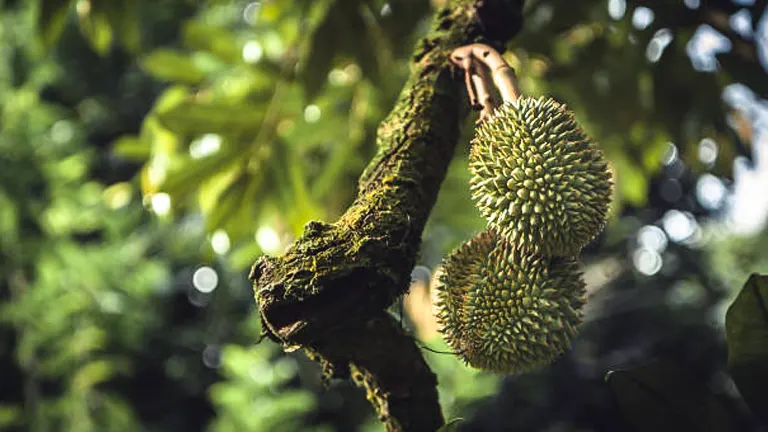
In this comprehensive guide, we’ll walk you through the essentials of durian tree fertilization, covering everything from the types of fertilizers to the timing of application, ensuring your journey from beginner to expert is as fruitful as your harvest.
Table of Contents
- Understanding Durian Trees
- Pre-Planting Considerations
- Basics of Fertilizing Durian Trees (Beginner)
- Advanced Fertilization Techniques (Intermediate to Expert)
- Step-by-Step Guide on How to Fertilize Durian Trees
- Planting Techniques for Success
- Monitoring and Maintenance
- Common Mistakes to Avoid
- Conclusion
- FAQs
Understanding Durian Trees
Basics of Durian Tree Requirements
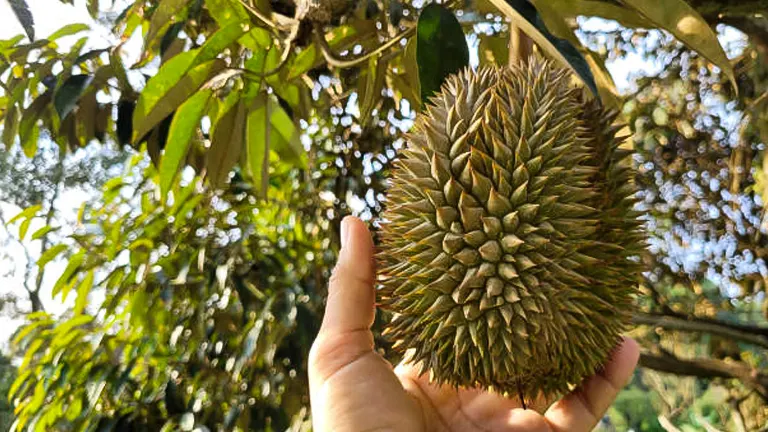
Durian trees (Durio zibethinus), native to Southeast Asia, are renowned not just for their distinctive fruit but for their specific cultural and environmental requirements. These majestic trees can grow up to 50 meters in height in their natural habitat, underpinned by a set of precise conditions that foster their growth and fruit production.
Botanical and Environmental Preferences
- Tropical Climate: Durian trees flourish in temperatures ranging from 22°C to 30°C, with high humidity levels of 75-80%. They are sensitive to sudden drops in temperature and cannot withstand frost, which is why they are predominantly found in equatorial regions.
- Soil Requirements: The ideal soil for durian cultivation is deep, fertile loam with good drainage. The pH level of the soil should be between 6.0 and 6.5, which facilitates optimal nutrient uptake. Poorly drained soils or waterlogged conditions can lead to root rot diseases, adversely affecting tree health and fruit production.
- Moisture and Rainfall: Durian trees require consistent moisture, especially during the flowering and fruit development stages. An annual rainfall of 1500 to 3000 mm, evenly distributed, is ideal. However, a dry period of 1-2 months is necessary before the onset of flowering.
Optimal Growth Conditions for Durian Trees
| Condition | Optimal Range/Description |
|---|---|
| Climate | Tropical, with temperatures of 24°C to 30°C |
| Humidity | 75% to 80% |
| Annual Rainfall | 1,500mm to 2,500mm |
| Soil Type | Well-drained loamy soil |
| Soil pH | 5.5 to 6.5 |
| Organic Matter | High presence recommended |
Importance of Fertilization

Fertilization transcends beyond mere growth enhancement; it is pivotal for the durian tree’s physiological and reproductive health. Durian trees are heavy feeders, requiring a comprehensive suite of nutrients to support their extensive root systems, large leaves, and, most notably, their sizable, nutrient-dense fruits.
Nitrogen (N), Phosphorus (P), and Potassium (K) form the core of the tree’s nutritional needs, supporting foliage growth, root development, and fruit production, respectively. However, durian trees also require a balanced intake of secondary nutrients such as Calcium (Ca), Magnesium (Mg), and Sulfur (S), alongside trace elements like Zinc (Zn), Boron (B), and Iron (Fe) to prevent nutrient deficiency symptoms and ensure optimal health and productivity.
Essential Nutrient Requirements for Durian Trees
| Nutrient | Role in Durian Growth | Optimal Concentration |
|---|---|---|
| Nitrogen (N) | Promotes leaf growth and canopy development | 1.0-1.5% of dry leaf weight |
| Phosphorus (P) | Supports root development and flowering | 0.2-0.5% of dry leaf weight |
| Potassium (K) | Crucial for fruit development and quality | 1.5-2.0% of dry leaf weight |
| Calcium (Ca) | Cell wall development and enzyme activation | 0.5-1.0% of dry leaf weight |
| Magnesium (Mg) | Central to chlorophyll production | 0.3-0.8% of dry leaf weight |
| Zinc (Zn) | Vital for protein synthesis and growth regulation | 30-100 ppm in soil |
| Boron (B) | Essential for cell wall synthesis and sugar transport | 20-50 ppm in soil |
Note: These amounts are indicative and should be adjusted based on soil test results, tree age, health, and environmental conditions.
Effective fertilization strategies must consider the timing of application to coincide with key growth stages: pre-flowering, post-flowering, and fruit development stages. This tailored approach ensures that nutrients are available when the tree most needs them, enhancing the quality of the fruit in terms of size, taste, and nutritional value.
Understanding the intricate balance of these requirements and the strategic application of fertilizers can significantly influence the durian tree’s productivity, making the difference between a mediocre harvest and an abundant yield of high-quality fruits. Thus, the science of fertilizing durian trees demands attention to detail, knowledge of the tree’s life cycle, and a commitment to sustainable agricultural practices.
Pre-Planting Considerations
Choosing the Right Location
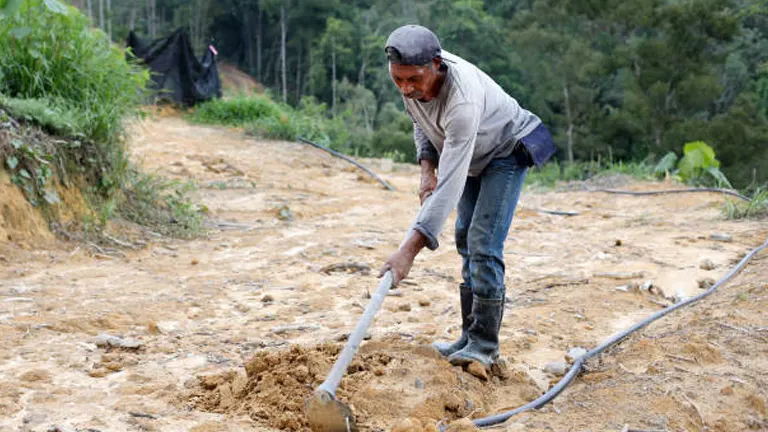
The choice of location is foundational. Durian trees require an area that receives ample sunlight and is protected from strong winds. Soil preparation, including pH adjustment to around 6-7 and ensuring good drainage, sets the stage for successful cultivation.
Planting Density for Durian Orchards
Decisions on planting density can significantly affect the orchard’s future. For medium-density farming, a spacing of 25 to 30 feet between trees is recommended, allowing for adequate sunlight and air circulation. High-density farming, aiming for maximized space usage, requires more intricate planning, with distances slightly reduced but ensuring each tree’s canopy has enough space to expand without shading its neighbors excessively.
Basics of Fertilizing Durian Trees (Beginner)
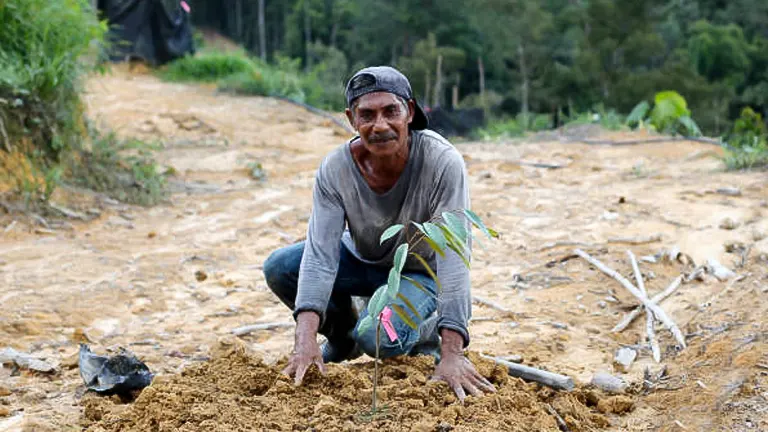
Understanding the nutritional requirements of durian trees and implementing a strategic fertilization plan is essential for their growth, health, and productivity. The durian tree’s life cycle includes several critical stages — from seedling to mature, fruit-bearing age — each with unique nutrient demands. Mastering these basics sets a strong foundation for a thriving orchard.
Optimal Fertilization Timings and Formulations
- When to Fertilize: The growth cycle of durian trees is intricately tied to seasonal patterns. Initiate fertilization at the start of the rainy season to leverage the natural water supply for nutrient dispersal. However, avoid fertilization immediately before or during the flowering stage to prevent nutrient overload, which can adversely affect fruit set.
- Choosing the Right Fertilizer: In the early stages, a balanced NPK (Nitrogen, Phosphorus, Potassium) fertilizer supports overall growth, but the specific formulation should evolve with the tree. Young trees benefit from a higher nitrogen content to promote foliage and structural growth, while mature, fruiting trees require increased potassium and phosphorus to support fruit development and root health.
Application Techniques for Effective Nutrient Uptake
How to Apply Fertilizer: The technique of application significantly affects nutrient uptake efficiency. Fertilizer should be applied in a circular band around the drip line of the tree, which is the outer circumference of the tree’s canopy where rainwater naturally drips off. This method encourages the roots to grow outward and access the nutrients more effectively.
For young trees, consider dividing the annual fertilizer amount into quarterly applications to ensure a steady supply of nutrients without overwhelming the tree. As trees mature, you can reduce the frequency but increase the amount per application, targeting the root zone’s expansion.
Watering Post-Application: Watering lightly after applying fertilizer helps integrate the nutrients into the soil, reducing the risk of volatilization (loss of nutrients to the air) and ensuring that the nutrients are accessible to the tree’s roots.
Nutrient Content Guide for Durian Trees
| Tree Age | N (Nitrogen) | P (Phosphorus) | K (Potassium) | Application Frequency |
|---|---|---|---|---|
| Seedling (0-2 years) | 1-2% | 1-1.5% | 1-1.5% | Quarterly |
| Juvenile (3-5 years) | 2-3% | 1.5-2% | 1.5-2% | Bi-annually |
| Mature (6+ years) | 1.5-2.5% | 2-3% | 3-4% | Bi-annually |
Note: Percentages are based on the recommended NPK ratio by weight of the total application. Adjustments may be required based on soil tests and tree health assessments.
Advanced Fertilization Techniques (Intermediate to Expert)
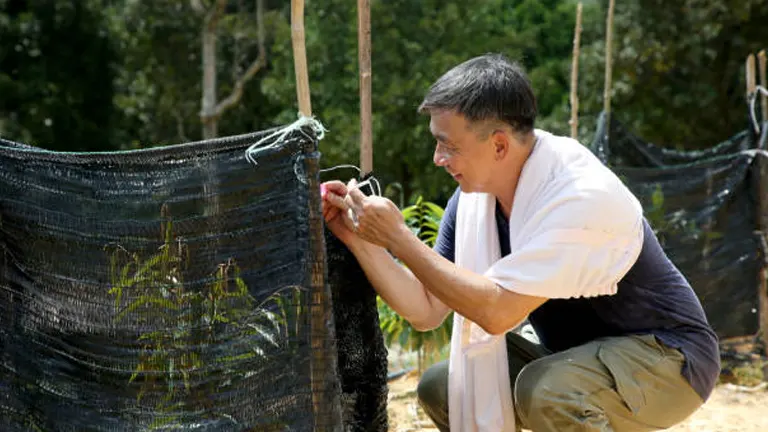
Understanding and implementing advanced fertilization techniques is crucial for the sustained health and productivity of mature durian trees. As these trees grow, their nutritional demands shift, necessitating a nuanced approach to fertilization that considers the tree’s lifecycle, soil health, and environmental factors.
Tailored Nutrient Formulations
Custom Fertilization Plans: Developing a custom fertilization plan requires a deep understanding of the durian tree’s growth stages. This plan should be dynamic, adapting to the tree’s changing needs throughout its lifecycle. For example, during the lead-up to the flowering phase, reducing nitrogen in favor of phosphorus can encourage blooming, while increasing potassium during fruit development supports fruit quality.
Application Strategy: Precision in application method and timing is key. Slow-release fertilizers can be particularly effective for mature trees, providing a steady supply of nutrients over time. In contrast, liquid fertilizers, applied via foliar feed, can offer immediate relief for acute nutrient deficiencies.
Micro-nutrient Management
While macronutrients are the primary focus of fertilization, micro-nutrients like zinc, boron, and magnesium play pivotal roles in the health and productivity of durian trees. Deficiencies in these elements can lead to poor growth, reduced fruiting, or even crop failure. Integrating micro-nutrient management into your fertilization regimen, either through foliar sprays or soil amendments, can significantly improve tree vitality and yield.
Essential Micro-nutrients and Their Impact:
| Micro-nutrient | Role in Tree Health | Optimal Soil Concentration |
|---|---|---|
| Zinc (Zn) | Essential for protein synthesis and growth regulation. Enhances disease resistance. | 5-20 ppm |
| Boron (B) | Critical for cell wall formation and fruit set. Affects nutrient transport within the tree. | 0.5-1.5 ppm |
| Magnesium (Mg) | Central component of chlorophyll, driving photosynthesis. Supports enzyme activation. | 50-150 ppm |
| Calcium (Ca) | Integral for cellular integrity and growth. Prevents blossom end rot in fruits. | 200-1500 ppm |
| Iron (Fe) | Necessary for chlorophyll synthesis and enzymatic functions. | 20-250 ppm |
| Manganese (Mn) | Involved in photosynthesis, nitrogen assimilation, and resistance to root pathogens. | 10-50 ppm |
Integrating Micro-nutrients into Your Fertilization Plan: Soil tests are invaluable for identifying specific micro-nutrient deficiencies. Based on these results, applying targeted foliar sprays or soil amendments can directly address the gaps, ensuring that your durian trees receive a balanced spectrum of nutrients. For example, foliar applications of chelated iron can correct iron chlorosis symptoms, characterized by yellowing leaves with green veins.
Step-by-Step Guide on How to Fertilize Durian Trees
Step 1: Understand Your Durian Tree’s Needs
- Recognize the growth stage of your tree—whether it’s a seedling, young non-fruiting, or a mature fruit-bearing tree—as this will dictate the type and quantity of fertilizer needed.
Step 2: Soil Testing
- Before you start fertilizing, test the soil to determine its nutrient content and pH level. Durian trees prefer slightly acidic soil (pH 6-7).
Step 3: Choose the Right Fertilizer
- Use a balanced NPK fertilizer for young trees. Mature trees require more potassium and phosphorus to support fruit development. Include a mix of micronutrients such as zinc, boron, and magnesium as well.
Step 4: Timing of Fertilization
- The best time to fertilize is at the onset of the rainy season, which helps in the absorption of nutrients. Avoid fertilizing just before or during the flowering stage.
Step 5: Fertilizer Application
- Apply fertilizer in a ring around the drip line of the tree—the area directly below the outer circumference of the tree’s branches.
- Young trees benefit from more frequent, lighter fertilization, while mature trees do better with less frequent but heavier applications.
Step 6: Watering After Application
- Water your tree lightly after applying the fertilizer to help integrate the nutrients into the soil and prevent the burning of roots.
Step 7: Monitor and Adjust
- Keep an eye on your tree’s growth, leaf color, and overall health as indicators of successful fertilization.
- If the tree shows signs of nutrient deficiency or excess, adjust the fertilization type, quantity, or frequency accordingly.
Step 8: Annual Review
- At the end of each year, review the fertilization plan based on the tree’s health, productivity, and the previous soil test results.
Step 9: Pruning for Nutrient Benefit
- Regularly prune your durian tree to remove dead or diseased branches, which can help the tree focus its energy and nutrients on healthy growth and fruit production.
Step 10: Record Keeping
- Keep detailed records of your fertilization schedules, soil test results, and any adjustments made. This information can help you understand what works best for your trees and make informed decisions in the future.
Additional Tips:
- Mulching: Apply organic mulch around the base of your trees to conserve moisture, regulate soil temperature, and reduce weed competition.
- Microbial Inoculants: Consider using microbial inoculants to enhance nutrient uptake and improve soil health.
- Professional Advice: If in doubt, seek advice from agricultural extension services or a professional horticulturist with experience in durian cultivation.
Planting Techniques for Success
Spacing and Density Explained
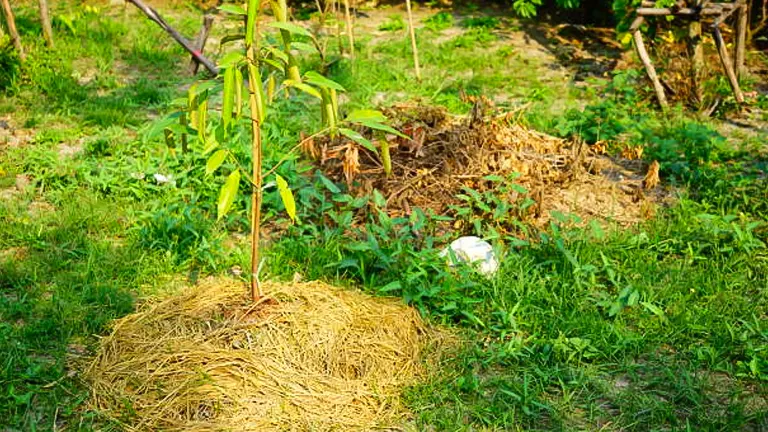
Achieving optimal spacing is critical in durian orchard management. The correct distance between trees minimizes competition for sunlight, water, and nutrients, which is crucial for the tree’s development and fruit production. For medium-density orchards, a spacing of 25 to 30 feet allows each tree ample room to grow without interference. High-density setups, while more challenging, can maximize land use but require careful planning to avoid overcrowding and nutrient depletion.
Training and Pruning Techniques
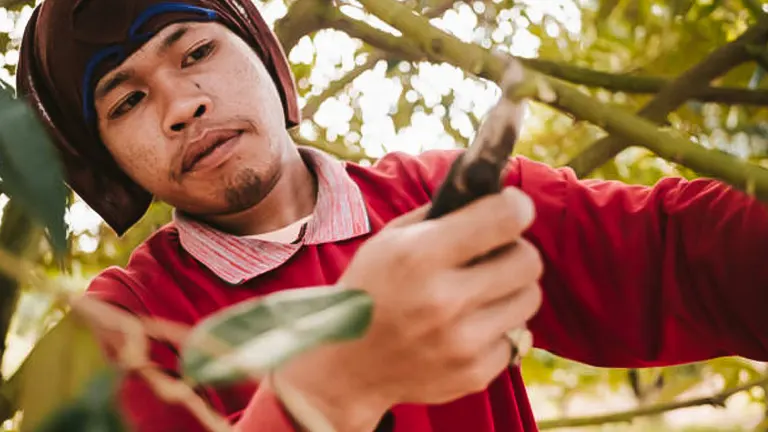
Training and pruning durian trees are essential practices that influence their health, shape, and productivity. Starting from the young age of the tree, training involves guiding the tree’s growth in a manner that promotes a strong structure, capable of supporting heavy fruit loads. Pruning, on the other hand, helps to remove dead or diseased branches, improve air circulation, and enhance sunlight penetration, which is vital for the development of flower buds and fruits.
- Practical Steps for Pruning: Begin by removing any branches that grow inward towards the tree’s center, aiming to create an open canopy that allows light to penetrate evenly. Additionally, pruning should be done carefully to maintain the tree’s balance and avoid excessive removal of foliage, which can stress the tree and reduce fruiting potential.
- Timing of Pruning: The best time to prune durian trees is after the harvest season when the tree is less susceptible to stress. This also prepares the tree for the next growth cycle by removing unproductive branches, thereby directing the tree’s energy towards new growth and fruit development.
These advanced techniques not only ensure the durian trees are receiving the right nutrients but also contribute to the structural integrity and health of the tree, which are critical for sustaining high yields over the years.
Monitoring and Maintenance
Evaluating Fertilization Efficacy
To ensure the health and productivity of durian trees, a rigorous and scientific approach to monitoring fertilization efficacy is essential. This involves a combination of soil and plant tissue analysis, coupled with visual assessments, to gather comprehensive data on the nutrient status and overall health of the trees.
- Soil Tests: Conducting soil tests at least annually provides a baseline of the soil’s nutrient content, pH level, and other characteristics crucial for optimal plant growth. This helps in customizing the fertilization program to address specific soil deficiencies.
- Leaf Analysis: Plant tissue analysis, especially leaf analysis, offers direct insights into the nutrient status of the trees. Comparing the nutrient content of leaves to standard nutrient levels for healthy durian trees can pinpoint specific deficiencies or toxicities.
- Growth Observation: Monitoring growth patterns, leaf color, and general vigor can indicate the tree’s health. Signs such as leaf chlorosis (yellowing) may suggest nutrient deficiencies, while stunted growth could indicate a broader issue with nutrient uptake.
Adjusting Your Approach
Given the dynamic nature of agricultural environments and the specific needs of durian trees as they progress through different growth stages, making informed adjustments to your fertilization strategy is crucial.
- Seasonal Adjustments: Durian trees have varying nutritional needs throughout the year, influenced by factors such as growth phase and weather conditions. For instance, the approach to fertilization will differ between the dry season and the wet season, with the former possibly requiring additional irrigation to support nutrient uptake.
- Developmental Adjustments: As trees mature from seedlings to fruit-bearing age, their nutrient requirements evolve. Young trees might benefit more from nitrogen for growth, while bearing trees need more potassium and phosphorus to support fruit development.
- Response-Based Adjustments: Reacting to the trees’ health and productivity signals by adjusting the fertilization plan can optimize nutrient management. For example, if leaf analysis indicates a magnesium deficiency, incorporating Epsom salts into the regimen could address this issue.
Durian Tree Monitoring and Maintenance Schedule
| Activity | Frequency | Purpose |
|---|---|---|
| Soil Testing | Annually | Assess soil nutrient levels and pH to tailor fertilization. |
| Leaf Analysis | Bi-annually | Verify nutrient absorption and identify deficiencies. |
| Growth Observation | Monthly | Monitor tree vigor and identify signs of nutrient imbalance. |
| Fertilizer Adjustment | Seasonally/As needed | Align fertilization strategy with tree growth stage and environmental conditions. |
| Watering Schedule Review | Seasonally | Ensure adequate moisture for nutrient uptake, especially in dry periods. |
Common Mistakes to Avoid
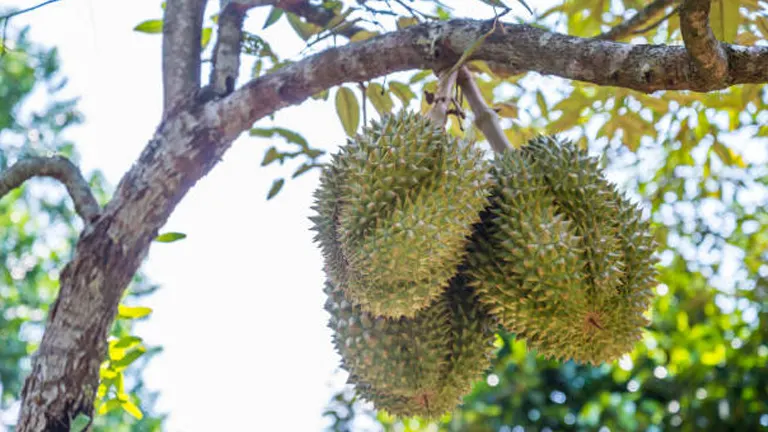
In the pursuit of a thriving durian orchard, certain common mistakes can hinder progress and negatively impact tree health and fruit yield. Awareness and avoidance of these pitfalls can significantly enhance your success rate.
- Over-Fertilization: While it’s tempting to provide your trees with an abundance of nutrients in hopes of boosting growth, over-fertilization can lead to nutrient burn, unhealthy growth patterns, and even reduce fruit quality. It’s vital to adhere to recommended application rates and observe tree responses carefully.
- Ignoring Soil pH: The absorption of nutrients is heavily influenced by soil pH. Ignoring soil pH levels can lead to nutrient lock-up, where trees cannot absorb the nutrients present in the soil, regardless of fertilization efforts. Regular soil testing and adjustments to maintain a pH of 6-7 are crucial.
- Neglecting Pruning and Training: Pruning and training are not just about maintaining a tree’s aesthetic appeal but are critical for ensuring good air circulation, sunlight penetration, and supporting fruit production. Neglecting these practices can lead to dense canopies that harbor pests and diseases, significantly impacting tree health and yield.
- Inconsistent Watering: Durian trees require consistent moisture, especially during the fruit development stage. Inconsistent watering can stress the trees, leading to poor fruit development or premature fruit drop. Implementing a regular watering schedule based on the season and tree needs is essential for maintaining healthy, productive trees.
Related Post:
Conclusion
Mastering the art of durian cultivation requires a balance of knowledge, patience, and adaptability. From selecting the right fertilizer to understanding the nuances of tree spacing and maintenance, every decision impacts the health of your durian trees and the quality of the fruit they produce. By avoiding common pitfalls and adjusting your strategies based on ongoing observations, you can ensure the prosperity of your durian orchard.
FAQs
- Can mulching benefit my durian trees along with fertilization?
Absolutely. Mulching around durian trees can conserve moisture, regulate soil temperature, and reduce weed competition. Organic mulches, like straw or wood chips, decompose over time, adding nutrients back into the soil and complementing your fertilization efforts. - How do I adjust fertilization for durian trees in containers vs. in-ground?
Durian trees in containers require more frequent fertilization than those planted in the ground due to limited soil volume and quicker nutrient depletion. Use a water-soluble, balanced fertilizer every 4-6 weeks during the growing season and reduce frequency in the dormant period. - What’s the role of micro-nutrients in fertilizing durian trees, and how do I incorporate them?
Micro-nutrients, such as zinc, magnesium, and iron, play crucial roles in the health and fruiting of durian trees. They’re typically applied through foliar sprays or added to the soil in chelated forms. Ensure to follow specific recommendations for each micro-nutrient to avoid toxicity. - How does the age of the durian tree influence its fertilization needs?
Young durian trees focus on establishing roots and foliage, requiring fertilizers higher in nitrogen for growth. As trees mature and begin to fruit, phosphorus and potassium become more critical for flower development and fruit production. Adjust the NPK ratio based on the tree’s life stage. - Is it necessary to water durian trees before and after fertilization?
Yes, watering before applying fertilizer can help prevent root burn and ensure the soil is moist enough for nutrient absorption. Watering after fertilization helps dissolve the fertilizer and distribute nutrients more evenly through the soil. - What are the signs of over-fertilizing a durian tree, and how can it be remedied?
Signs include yellowed, wilted, or burned leaves, stunted growth, and salt buildup in the soil. To remedy, cease fertilization, increase watering to flush out excess nutrients, and, if severe, remove affected soil and replace it with fresh, uncontaminated soil. - Can climate affect how and when I fertilize my durian trees?
Definitely. In regions with distinct wet and dry seasons, it’s best to fertilize just before the rainy season to enhance nutrient uptake. In more temperate climates, adjust your fertilization schedule to coincide with active growth periods in spring and summer. - How do I prevent nutrient leaching in sandy soils when fertilizing durian trees?
In sandy soils, nutrients can wash away more quickly. To minimize leaching, consider using slow-release or organic fertilizers that provide a steady supply of nutrients. Additionally, incorporating organic matter into the soil can improve its ability to hold nutrients and moisture.
As we wrap up our guide on fertilizing durian trees, remember that each step you take brings you closer to a thriving orchard. Whether you’re just starting out or refining your expertise, the right approach to fertilization can make all the difference. Keep learning, stay observant, and your durian trees will reward you generously. Here’s to your success in growing the king of fruits!
For more expert gardening advice, explore our guides, discover top recommendations in our best section, and delve into in-depth product reviews in our review section.

Benjamin Brooks
Forestry AuthorGreetings! I'm Benjamin Brooks, and my journey over the past 15 years has revolved around the fascinating realms of content creation, expertise in snow clearing, and the intricate world of lumberjacking and landscaping. What began as a simple curiosity about the natural world and heavy machinery has evolved into a passionate profession where my love for crafting words intertwines seamlessly with my lumberjacking and garden skills.




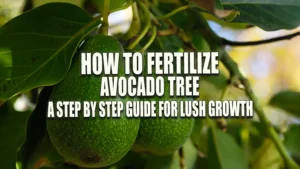








Very useful information 👌
Mohamed Mousoom
March 27, 2024 2:59 am